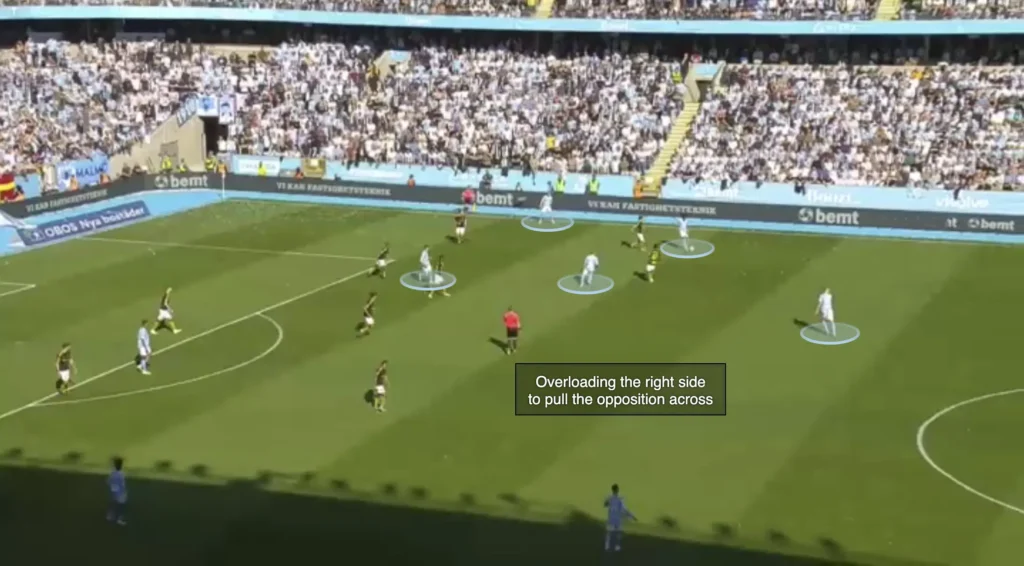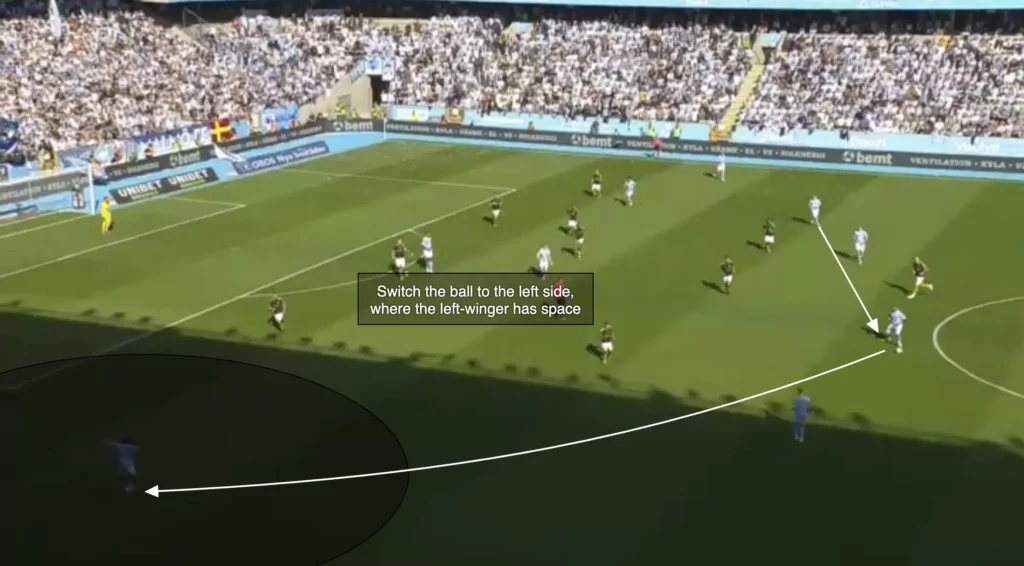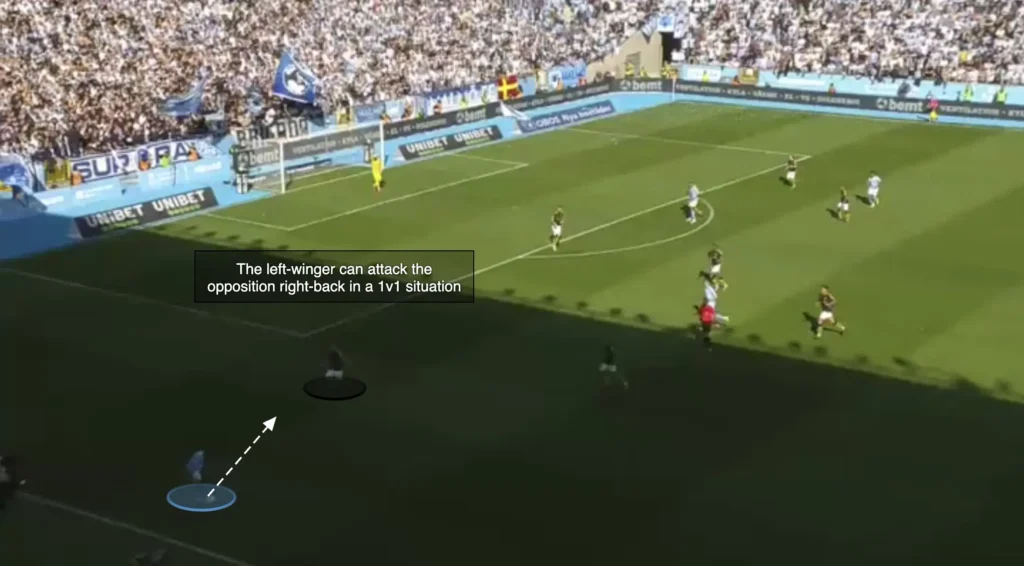Modern football is increasingly about controlling space rather than simply controlling possession. Compact defensive blocks restrict central access, and teams often struggle to progress without deliberate manipulation of the opposition’s shape. One of the clearest and most repeatable mechanisms for creating attacking advantage is the overload-to-isolate principle: concentrating numbers in one area to attract the defense, then shifting play to release an attacker in a favorable 1v1.
This principle is not a fashionable trend but a structural way of thinking about attack. It is adaptable to different formations, player profiles, and phases of play. For coaches, it provides a clear reference to organize training and game plans; for analysts, it offers a framework to interpret attacking strategies.
The Concept: Overloading to Isolate
At its core, overload-to-isolate is about creating superiority in one zone to generate space in another.
1. The Overload
- The attacking team deliberately crowds one side with multiple players (often 4–5 within a short distance).
- This compresses the opposition block horizontally, forcing defenders to shift across and protect the ball-near zone.

2. The Switch
- Once defenders are committed, the ball is circulated quickly — via diagonal switch, central pivot, or circulation across the backline.
- The aim is to exploit the moment before the defense can rebalance.

3. The Isolation
- A predetermined attacker (commonly a winger, wing-back, or fullback) receives wide and high, ideally in a pure 1v1 duel.
- The success of the mechanism depends on the quality of the isolated player and the timing of support movements around them.

Why Coaches Use Overload-to-Isolate
1. To Break Compact Blocks
Low- and mid-blocks prioritize central congestion. Overloading one flank forces the defense to overcommit and opens up the far side, allowing penetration in areas they initially intended to protect.
2. To Maximize Player Strengths
For teams with strong dribblers or dynamic fullbacks, it is often counterproductive to give them the ball in crowded zones. Isolation creates favorable duels, raising the probability of progression or chance creation.
3. To Force Defensive Decisions
Defensive units cannot protect everything. If they shift aggressively toward the overload, they leave the far side free; if they hold shape, the overload itself becomes the attacking advantage. Either way, the attacking team dictates the problem.
4. To Add Purpose to Circulation
Lateral ball movement without intent can be sterile. Overload-to-isolate provides a clear attacking narrative: attract → shift → exploit. This prevents meaningless possession and creates tangible goals within each attack.
How to Implement It in Training
1. Designing the Overload
- Use the fullback inside movement or fluid midfielders to crowd the ball-side.
- Encourage 3v2 or 4v3 superiority in tight areas.
- Stress to players that the overload is not the end goal — it is a trigger.
2. Timing and Recognition of the Switch
- The switch must come once the defensive block is fully engaged but before it can reorganize.
- The central midfielders and center-backs are crucial: they need the awareness to recognize the moment and the passing range to execute it.
3. Preparing the Isolated Player
- Positioning: wide and high to maximize available space.
- Body orientation: facing forward, ready to attack on the first touch.
- Support: overlapping fullback or underlapping midfielder to add depth and options once the 1v1 is engaged.
4. Example Drills
- Rondo With Release: 6v3 overload on one side, must find the far-side winger after 5 passes.
- Half-Pitch Build-Up: Overload on the left with pivot options, quick release to isolated right winger for 1v1.
- Positional Play Grids: Train players to read cues — when to sustain overload, when to trigger switch.
Defensive Counter-Adaptations and Coaching Responses
No tactic works in isolation — defenses adapt. Coaches must anticipate the main responses and build variations.
- Fullback Staying Wide
- Some teams leave their far-side fullback deeper and wider, ready for the switch.
- Coaching response: adjust the isolation zone — sometimes half-space isolation is more dangerous than pure touchline isolation.
- Winger Tracking Back
- Opponents may ask wingers to cover the isolated attacker on switches.
- Coaching response: overload can double as a fatigue mechanism — repeated tracking weakens the winger’s attacking threat later in the match.
- Narrow Midfield Shifts
- Midfields sliding heavily toward the ball-side can close central options.
- Coaching response: emphasize third-man combinations in the overload to progress centrally before the switch.
- Aggressive Pressing in the Overload
- If opponents counter-press the overload zone, they try to prevent the switch.
- Coaching response: train secure possession under pressure and rehearse emergency diagonals to bypass the press.
Analytical Perspectives
For analysts, overload-to-isolate offers a framework to:
- Evaluate effectiveness: Are switches leading to genuine isolations, or are defenders arriving on time?
- Track player roles: Who initiates the overload, who executes the switch, who benefits from isolation?
- Assess tempo: Are switches happening quickly enough, or is the defense recovering?
- Measure risk-reward: Are teams leaving rest-defence stable enough while committing numbers to overload?
This lens makes it possible to evaluate not just whether a team uses the principle, but how effectively it is executed.
Practical Application for Coaches
- Match Preparation: Identify which defenders are most vulnerable to isolation. Structure overload-to-isolate plans around targeting them.
- Player Development: Train wingers to exploit isolated 1v1s and central players to recognize pressing cues in overload zones.
- In-Game Adjustments: If the switch is consistently being covered, adapt by progressing through the overload itself.
By embedding this principle, coaches can turn possession phases into purposeful attacking strategies rather than sterile circulation.
Conclusion
Overload-to-isolate is a fundamental principle of modern attacking football, rooted in space manipulation and decision-making. It provides coaches with a clear tool: attract the block, shift the ball, and release the danger player into optimal conditions.
The concept is not about stylistic preference — it is about structuring attacks around space and superiority. When trained systematically and executed with precision, overload-to-isolate offers a reliable way to break down compact defenses, maximize individual talent, and dictate the rhythm of the game.
In a sport increasingly defined by marginal gains, this principle ensures that possession is not just maintained but weaponized. For coaches and analysts, it provides a repeatable lens through which to understand, train, and evaluate attacking play.

I love how much you use Malmo as an example, whoever runs this page knows a lot of football.